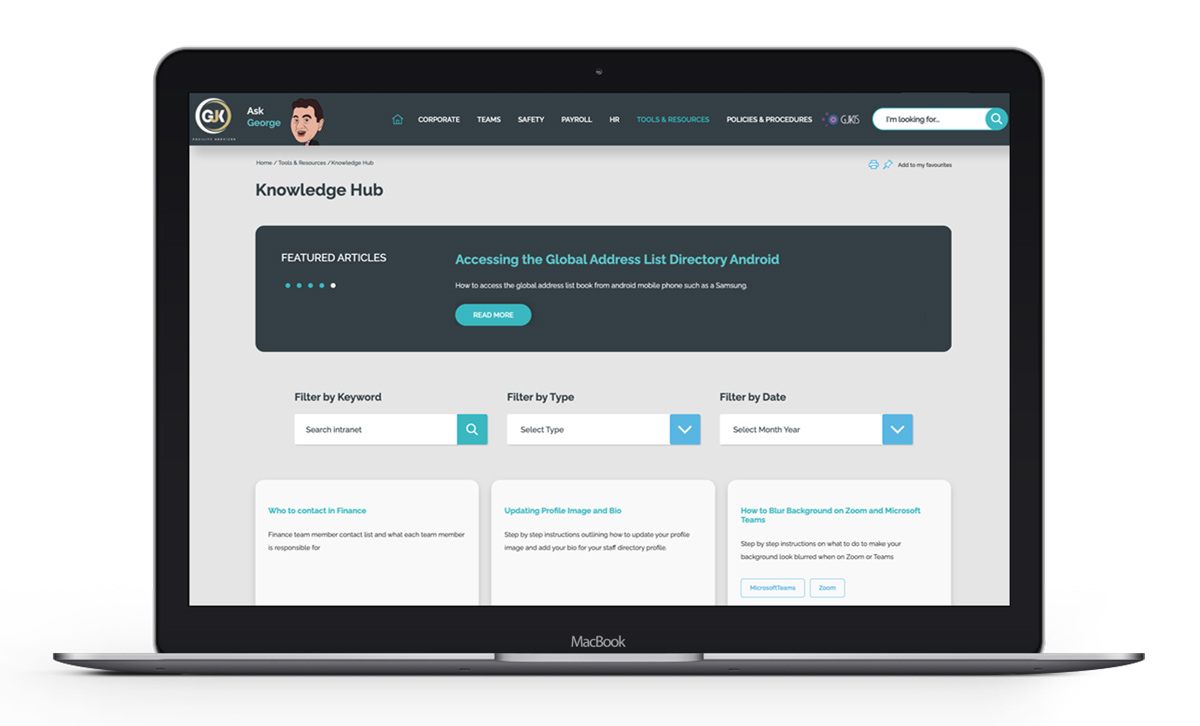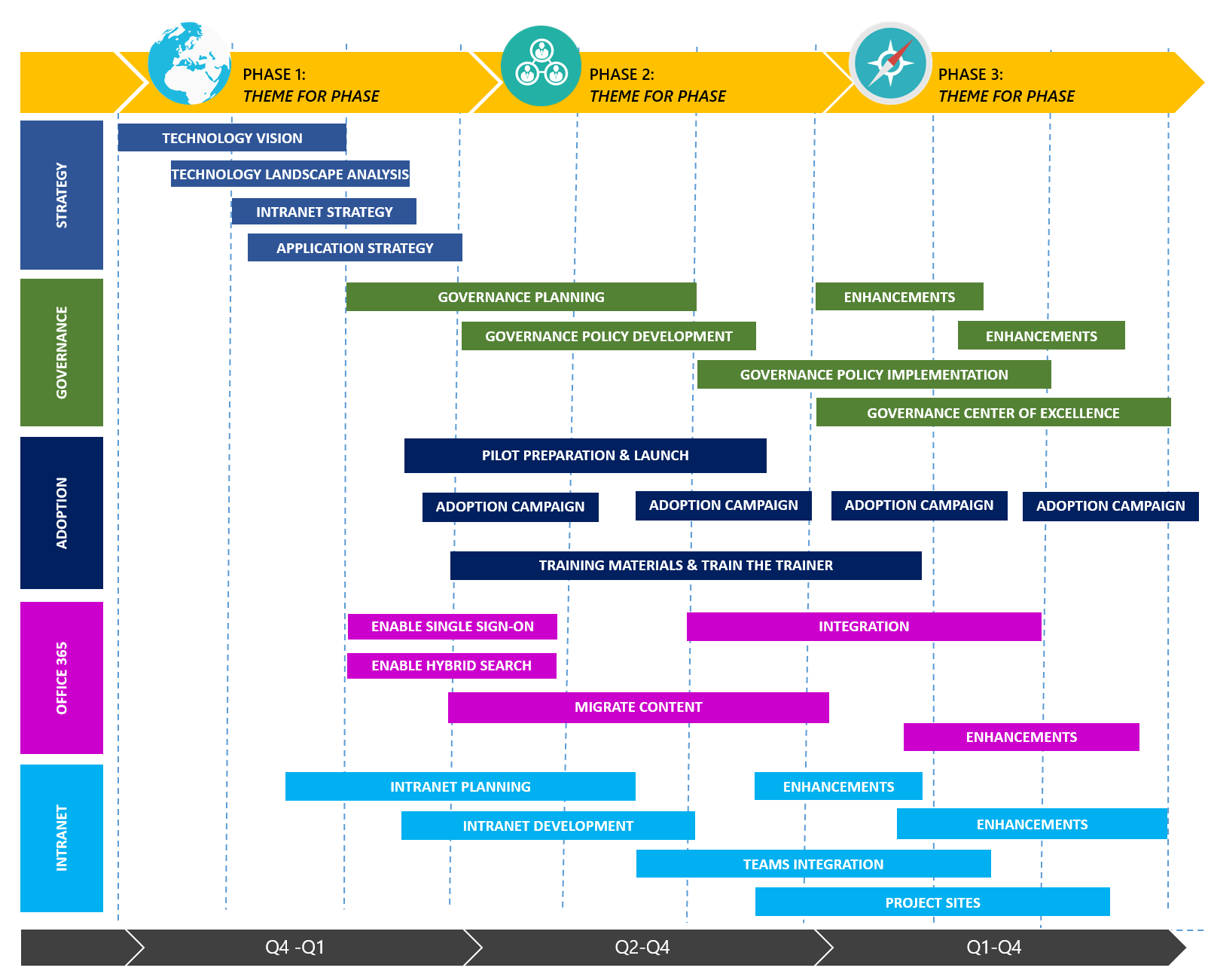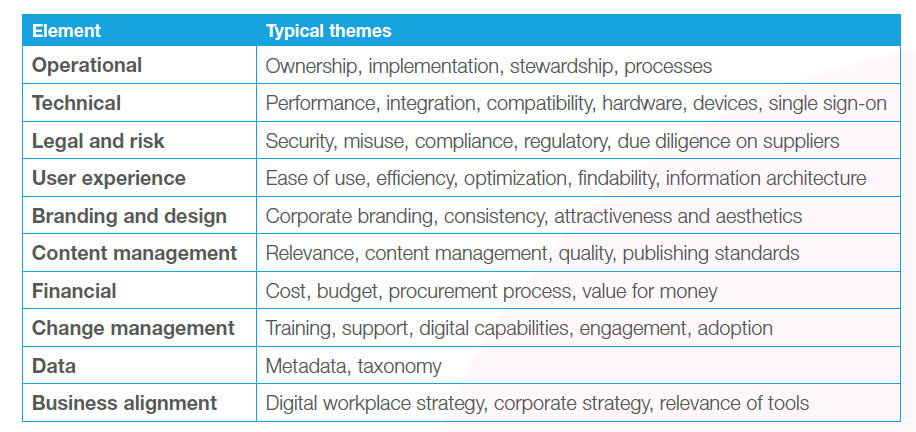Digital workplace management is not just about implementing technology; it's about fostering a culture that embraces digital transformation, ensuring robust governance, and continuously adapting to the evolving digital landscape.
Digital workplace benefits are manifold. It can lead to increased productivity, better employee engagement, and more efficient communication.
However, it's not without its challenges. Digital workplace challenges can include ensuring data security, managing the change in organisational culture, and keeping up with the rapid pace of technological change. This is why it’s important to put in place strategies to improve your digital workplace management.
But what does this entail, and how can you ensure you're leveraging the right tools and technologies to their fullest potential?
What Does a Digital Workplace Look Like?
Firstly, let's demystify the term. What is a digital workplace?
In simple terms, it refers to a virtual equivalent of the physical workplace. This encompasses all the technologies staff use to do their jobs. This can include email, instant messaging, intranet services, enterprise social media tools, and online meeting software. The digital workplace extends beyond mere tools; it's about creating a seamless experience that supports employees in their day-to-day tasks, regardless of their location.
A well-structured digital workplace offers a centralised platform where employees can access information, communicate, and collaborate efficiently. For instance, an intranet solution like Elcom's can serve as the backbone of your digital workplace, offering a range of tools tailored to enhance internal communications and streamline processes.
Why is Digital Workplace Management Important?
Effective digital workplace management is pivotal for several reasons. Digital workplace benefits include having technology that aligns with business goals, enhancing employee engagement, and improving overall productivity.
Digital workplace management involves overseeing the digital tools and platforms used by your organisation and ensuring they are optimised to meet the needs of your workforce.
Digital Workplace Tools and Technologies
You can't have a digital workplace without the tools and technologies within your digital ecosystem.
Let's delve into what a digital workplace that ultimately succeeds encompasses.
Types of Digital Workplace Tools
Digital workplace tools can be broadly categorised into several types:
Communication Tools
Communication tools include email platforms, instant messaging apps, and video conferencing systems. They are essential for ensuring clear and consistent communication across your organisation.
Collaboration Tools
Online collaboration tools like shared workspaces, project management software, and real-time document editing and sharing platforms help in fostering teamwork and collaboration.
Productivity Tools
These are software and applications that help manage individual tasks and time, such as calendar apps, to-do list software, and note-taking apps.
Knowledge Management Systems
These systems are crucial for storing, organising, and accessing company information and resources.

Example of a Knowledge Hub from the GJK Facilities Intranet.
Choosing the Right Tools
Selecting the right tools for your digital workplace is a critical decision. Here are some tips to guide you:
Conduct a Thorough Needs Analysis
While there are several digital workplace trends that might influence your decisions. The real foundation of a great digital workplace starts with a thorough needs analysis of your own organisation.
Engage with different departments to identify their unique challenges and requirements. For instance, your marketing team might benefit from advanced project management software, while your HR department might need a robust employee engagement and feedback tool. This analysis should also consider the size of your organisation, the nature of your work, and the existing technological infrastructure.
Evaluate User Experience
The success of any digital tool largely depends on its user adoption. Select tools that offer an intuitive user interface and a positive user experience. Tools that are overly complex or difficult to navigate can lead to low adoption rates, negating their potential benefits.
Integration and Compatibility
Check how well new tools will integrate with your existing digital environment. The goal is to create a seamless workflow where data and information can be easily transferred across different platforms. For example, your project management tool should ideally integrate with your existing email system and calendar applications.
Scalability and Flexibility
The digital tools you choose should be able to scale with your organisation. They should be adaptable to accommodate growing numbers of users, increasing data volumes, and evolving business processes. This foresight will save you from frequent tool changes, which can be disruptive and costly.
Security and Compliance
In today's digital age, security cannot be overstated. Ensure that the tools you choose comply with industry standards and regulations, especially regarding data protection and privacy. This is particularly crucial for organisations handling sensitive client or customer information.
Cost-Effectiveness
While it's important to invest in quality tools, it's equally important to consider the cost. Evaluate the pricing models of different tools and consider their ROI. Some tools might offer a higher upfront cost but provide more value in the long run, while others might be subscription-based but less robust.
Vendor Reputation and Support
Research the vendors of your shortlisted tools. Look for reviews, case studies, and testimonials from other organisations, especially those similar to yours in size and industry. Additionally, consider the level of support and training the vendor offers. Good vendor support can significantly ease the implementation and troubleshooting process.
Trial and Feedback
Before making a final decision, if possible, use a trial version of the tool. Encourage your team to test these tools in their daily tasks and provide feedback. This hands-on experience can be invaluable in assessing the tool's practicality and fit for your organisation.
Future-Proofing
Lastly, consider the future trajectory of the tool.
Is the vendor known for regularly updating and improving their product? Does the tool have the potential to integrate to third party systems? Is it scalable if your organisation grows? Choosing tools that are likely to evolve with technological advancements can be a wise long-term strategy.
Managing Workplace Tools Effectively
Once you have your suite of tools, managing them effectively is crucial.
Here are some strategies for success:
Structured Implementation Plan
Develop a comprehensive plan for rolling out new tools. This should include timelines, key milestones, and designated responsibilities. Ensure that everyone involved understands the plan and their role in it. A phased approach can be beneficial, starting with a pilot group before a full-scale rollout.

Sample digital workplace roadmap by Richard Harbridge.
Training and Support
One of the biggest hurdles in adopting new tools is resistance from employees, often due to a lack of understanding of how to use them. Invest in thorough training sessions that are tailored to different user groups' needs. Also, ensure ongoing support is available, whether through in-house IT staff, external vendors, or a combination of both.
Regular Monitoring and Evaluation
Keep track of how the tools are being used and their impact on productivity and collaboration. Use metrics and KPIs to measure success and identify areas for improvement. This could include user engagement levels, the speed of task completion, or the quality of collaborative efforts.
Feedback Mechanism
Establish a clear and open channel for employees to provide feedback on the tools. This feedback is invaluable for understanding real-world usage challenges and areas where the tools may not meet user needs. Regular surveys, suggestion boxes, or informal check-ins can be effective methods for gathering this feedback.
Updates and Maintenance
Technology evolves rapidly, and digital tools are no exception. Stay on top of updates and maintenance to ensure your tools remain secure, efficient, and aligned with the latest technological advancements. This also involves retiring tools that are no longer beneficial or upgrading to more advanced solutions when necessary.
Integration Management
As your digital tool ecosystem grows, managing integrations between different tools becomes crucial. Ensure that data flows seamlessly between systems and that these integrations don’t create silos or data integrity issues.
Security and Compliance Oversight
Regularly review your tools to ensure they comply with relevant data protection regulations and security standards. This is especially important for tools that handle sensitive or personal data. Conduct periodic security audits and risk assessments.
Change Management
Effectively managing workplace tools also involves managing the change they bring to your organisation. This includes addressing the human side of change – helping employees to understand, adapt to, and embrace these new tools. Effective change management practices can significantly enhance the adoption and effectiveness of new technologies.
Scalability and Flexibility Assessment
As your organisation grows and evolves, your tools should be able to keep up. Regularly assess whether your current tools are scalable and flexible enough to meet changing demands. This might involve adding more licenses, expanding features, or even switching to more robust platforms.
Fostering a Culture of Continuous Improvement
Encourage a workplace culture that is open to learning and adapting. This means not just getting comfortable with the current set of tools but being open to exploring and experimenting with new technologies that could further enhance productivity and collaboration.
Digital Workplace Governance
Effective digital workplace governance is crucial for maximising the benefits of your digital tools and ensuring they contribute positively to your organisation's goals.
Importance of Digital Workplace Governance
The digital workplace is an integrated technology framework that enables productivity and collaboration across various platforms and tools.
However, with the adoption of these digital tools comes the need for governance – a set of policies, roles, responsibilities, and processes that guide and control how these tools are used and managed.
Effective digital workplace governance ensures that your organisation's digital tools align with business goals, comply with legal and regulatory requirements, and meet the needs of all users.
It's about striking the right balance between control and flexibility, ensuring that employees have the freedom to collaborate and innovate while maintaining data security and operational efficiency.
Developing a Digital Workplace Governance Framework
Creating a governance framework for your digital workplace involves several key steps:
Define Clear Objectives
Start by outlining what you want to achieve with your digital workplace. This could include improving internal communication, enhancing collaboration, or streamlining processes. Your objectives should align with your overall business strategy.
Establish Roles and Responsibilities
Identify who will be responsible for managing and overseeing your digital workplace. This includes defining roles for content management, user support, and technology oversight. It's crucial to have a dedicated team or individual responsible for the governance of your digital workplace.
Develop Policies and Procedures
Create clear policies and procedures that dictate how digital tools should be used. This includes guidelines on content creation and sharing, data privacy, and user behaviour. Ensure these policies are easily accessible and understood by all employees.
This will be dependent on your own organisations. However, policies and procedures usually relate to the following elements: operational, technical, legal and risk, user experience, branding and design, content management, financial, change management, data and business alignment.

Example of digital workplace governance framework elements and themes that you might consider from Digital Workplace Group.
Implement Security Measures
With the rise of cyber threats, security is a critical component of digital workplace governance. Implement measures to protect sensitive data and ensure compliance with data protection laws. Regularly review and update these security measures to address new risks.
Training and Support
Provide comprehensive training and ongoing support to ensure that all employees are equipped to use the digital tools effectively. This includes training on best practices, security protocols, and how to use specific tools.
Monitor and Review
Governance is not a set-and-forget process. Regularly monitor how digital tools are being used and review their effectiveness. Be prepared to adapt your governance framework in response to new challenges, technological advancements, or changes in business strategy.
Encourage Feedback and Participation
Involve employees in the governance process by encouraging feedback and suggestions. This not only helps in identifying areas for improvement but also fosters a sense of ownership and engagement among the workforce.
Digital Workplace Culture
A strong digital workplace culture offers numerous benefits. It enhances employee engagement, improves communication, and boosts overall productivity. In a well-cultivated digital culture, employees feel valued and connected, which in turn drives innovation and job satisfaction.
However, creating this culture is not without its challenges. Digital workplace challenges include overcoming resistance to new technologies, bridging the gap between different departments and locations, and ensuring consistent and effective communication across all levels of the organisation.
How to Create a Positive Digital Workplace Culture
Here are some strategies for cultivating a positive digital workplace culture:
Promote Open and Transparent Communication
Encourage a culture where feedback is valued and information is shared openly. Utilise your digital tools, such as intranets and collaboration platforms, to facilitate transparent communication.
Encourage Collaboration and Social Interaction
Foster a sense of community by using digital tools that enable social interaction and collaboration. This could include setting up virtual meeting rooms, social channels, or interest groups on your intranet.
Recognise and Reward Contributions
Use digital platforms to acknowledge individual and team achievements. Public recognition can be a powerful motivator and can reinforce a positive culture.
Provide Training and Support
Ensure that all employees are comfortable and proficient with the digital tools at their disposal. Regular training sessions and easily accessible support can help alleviate any apprehension about using new technologies.
Lead by Example
Leadership plays a crucial role in setting the tone for workplace culture. Encourage leaders and managers to actively use digital tools and champion the benefits of a digital workplace.
Managing Change and Resistance
Change is often met with resistance, and the shift to a digital workplace is no exception. Here are some strategies to manage this transition:
Communicate the 'Why'
Clearly explain the reasons behind the shift to a digital workplace and how it benefits the organisation and its employees.
Involve Employees in the Process
Give employees a voice in the transition. Gather their input and feedback on the tools and processes being implemented.
Provide Clear Expectations and Guidelines
Set clear expectations about how the digital tools should be used. Develop guidelines that help employees understand the do's and don'ts of the digital workplace.
Monitor and Adjust
Be prepared to adjust your strategy based on feedback and the evolving needs of your organisation. Continuous improvement should be a key component of your digital workplace strategy.
Conclusion
Navigating the complexities of digital workplace management requires a strategic and holistic approach. As we've explored, the key elements – from understanding the makeup of a digital workplace to implementing effective governance and nurturing a positive digital culture – are integral to the success of any modern organisation.
The journey towards an efficient digital workplace is ongoing, demanding continuous adaptation and a keen understanding of both technological advancements and human dynamics.
By prioritising clear communication, fostering collaboration, and ensuring that digital tools align with business goals, they can turn potential digital workplace challenges into opportunities for growth and innovation.
Ultimately, the goal is to create an environment where technology empowers, rather than impedes, fostering a culture of efficiency, engagement, and continuous improvement. In doing so, organisations can unlock the full potential of their digital workplace, driving success in an increasingly digital world.
For more insights, we recommend you read the guide 'How to Build a Productive and Engaged Digital Workplace'.
